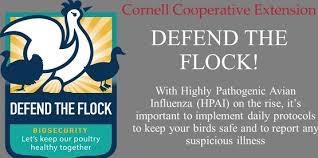 On May 31st, the USDA announced that it would assign an additional $400 million to pay for control of Highly Pathogenic Avian Influenza (HPAI), including compensation for owners of close to 39 million birds depleted during the 2022 epornitic. Funding will be derived from the Commodity Credit Corporation and will represent the third tranche following $393 million in the second allocation.
On May 31st, the USDA announced that it would assign an additional $400 million to pay for control of Highly Pathogenic Avian Influenza (HPAI), including compensation for owners of close to 39 million birds depleted during the 2022 epornitic. Funding will be derived from the Commodity Credit Corporation and will represent the third tranche following $393 million in the second allocation.
During February and March EGG-NEWS advocated for APHIS to provide poultry producers with preliminary guidance based on an initial epidemiologic evaluation of outbreaks. It is evident to poultry health professionals that the epidemiology of the 2022 epornitic including shedding by wild birds, timing and distribution of outbreaks along the four flyways, the occurrence of the infection in backyard flocks differed from 2015. A preliminary opinion in early April may well have prevented some outbreaks, especially among the more expensive and cases involving egg production complexes. Information on the mode of spread would have been beneficial to producers of commercial turkeys in Minnesota, Iowa and the Dakotas.
 Advice on prevention, provided by APHIS, was no different from the basic biosecurity recommendations developed during and subsequent to the 1984 and 2015 epornitics. Surely, initial evaluation based on real-time assessment of risks of introduction of the 2022 H5N1 strain and application of molecular epidemiology could have indicated specific changes required to enhance biosecurity and reduce the number of outbreaks. If APHIS lacked epidemiologists and qualified poultry health professionals, then they should have outsourced investigations to the faculty at Land Grant universities in the affected states.
Advice on prevention, provided by APHIS, was no different from the basic biosecurity recommendations developed during and subsequent to the 1984 and 2015 epornitics. Surely, initial evaluation based on real-time assessment of risks of introduction of the 2022 H5N1 strain and application of molecular epidemiology could have indicated specific changes required to enhance biosecurity and reduce the number of outbreaks. If APHIS lacked epidemiologists and qualified poultry health professionals, then they should have outsourced investigations to the faculty at Land Grant universities in the affected states.
Requests were made to the USDA-APHIS during mid-April for an opinion on the mode of introduction onto farms. This should have resulted in relevant guidance as a realistic response. An interim report would have been more valuable at the time than a more comprehensive document in 2023.
 It is apparent that Highly Pathogenic Avian Influenza can be regarded as seasonally endemic given the role of migratory birds. Eradication based on the incorrect presumption that HPAI is an exotic infection will only lead to a repetition of the mass depopulations of 2015 and 2022.
It is apparent that Highly Pathogenic Avian Influenza can be regarded as seasonally endemic given the role of migratory birds. Eradication based on the incorrect presumption that HPAI is an exotic infection will only lead to a repetition of the mass depopulations of 2015 and 2022.
The industry urgently requires epidemiologic evaluation of the 2022 epornitic with comparisons to the 2015 outbreak. The Industry deserves an analysis of any deficiencies in biosecurity based on molecular biology and traditional case-controlled studies. This will allow the U.S. industry to be more prepared for a subsequent inevitable outbreak.